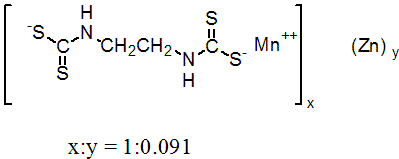Common name: Mancozeb
Another name: Dithane M-45, Manzate 200, Mancozeb, Fore, Green-Daisen M, Karamate, Mancofol, Zimaneb, Manzeb, Policar, Dithane- Ultra Nemispot, Nemispor, Riozeb, Mancozin, Manzin. Common names include mancozeb and manzeb
Chemical Name (IUPAC): manganese ethylenebis(dithiocarbamate) (polymeric) complex with zinc salt
Structural formula:

Empirical formula: (C4H6MnN2S4)x(Zn)y
Mol. Weight: 271.2
CAS No.: 8018-01-7
Specifications:
Leading Mancozeb supplier
Mancozeb 85% TC
Mancozeb 80% WP
Mancozeb 75% WDG
Mancozeb 60% WP
Packing
BULK PACKING
Powder: 25KG/Bag, 25KG/Drum, 50KG/Drum etc.
SMALL PACKING
Powder: 1kg/Alu bag, 500g/Alu bag, 200g/Alu bag, 100g/Alu bag, 50g/Alu bag, 15g/Alu bag etc.
Customerized Packing label
Mancozeb FAO standard
Professional registration
HAZARDS IDENTIFICATION:
GHS Hazard statement(s)
H317: May cause an allergic skin reaction.
H361: Suspected of damaging fertility or the unborn child.
H400: Very toxic to aquatic life.
PREVENTION
P201: Obtain special instructions before use.
P202: Do not handle until all safety precautions have been read and understood.
P261: Avoid breathing fumes, mists, vapours or spray.
P262: Do not get in eyes, on skin, or on clothing.
P272: Contaminated work clothing should not be allowed out of the workplace.
P273: Avoid release to the environment.
P280: Wear protective gloves, protective clothing and eye or face protection.
P281: Use personal protective equipment as required.
RESPONSE
P363: Wash contaminated clothing before reuse.
P301+P330+P331: IF SWALLOWED: Rinse mouth. Do NOT induce vomiting. P302+P352: IF ON SKIN: Wash with plenty of soap and water.
P308+P313: If exposed or concerned: Get medical advice.
P333+P313: If skin irritation or rash occurs: Get medical advice.
STORAGE
P410: Protect from sunlight.
P402+P404: Store in a dry place. Store in a closed container.
MAMMALIAN TOXICOLOGY
Acute toxicity: 1) Acute oral LD50 for rats >5000 a.i.mg/kg; 2) Acute percutaneous LD50 for rats >2000 a.i.mg/kg. 3) Acute inhalation toxicity LC50 (4h) for rats: >5.14 a.i. mg/L; 4) Skin irritation: Not an irritant (rabbits). 5) Eye irritation for rabbit: non irritating; 6) Skin sensitization for guinea pig: not a sensitize.
Carcinogenicity data: A two-year feeding study of mancozeb in rats produced an increased incidence of thyroid tumors at 750ppm (29mg/kg/day). No evidence of carcinogenicity was observed in long-term studies with mice.
Mutagenicity data: Both mancozeb and ETU have been adequately tested in wide variety of in vitro and in vivo mutagenicity tests. The weight of the evidence of these tests indicates that mancozeb and ETU are not mutagenic in mammalian systems. Reproductive/Teratology data: No reproductive effects were seen below exposure levels high enough to produce non-reproductive toxic effects in two-generation reproduction studies of mancozeb or ETU in rats.
Sensitization data: Mancozeb causes skin sensitization in guinea pigs when tested using the maximization procedure, but not when tested using the Buehler procedure. Consequently, mancozeb may have a weak potential for skin sensitization in humans.
ADI (JMPR) 0.03 mg/kg b.w. (group ADI with maneb, metiram and zineb); ethylenethiourea 0.004 mg/kg b.w. [1993]; mancozeb 0.05 mg/kg b.w.
Classification:
EC Risk Classification: Reproduction risk category 3: R63
Xn - Harmful: R43
N - Dangerous for the environment: R50
WHO Classification: U (Unlikely to present an acute hazard)
US EPA Classification (formulation): IV(Caution - Not acutely toxic)
ECOTOXICOLOGY
Effect on birds: low toxicity to birds, Acute LD50 for Japanese quail is >2000 a.i. mg/kg. Effects on Fish: high toxicity to fish, Acute LC50 (96h) for rainbow trout is 0.074 a.i.mg/L. Effects on Aquatic invertebrates: hight toxicity to Aquatic invertebrates, Acute LC50 (48h) for daphnia magan is 0.073 a.i.mg/L. Effects on Algae: moderate toxicity to algae, Acute hour EC50 (72h), growth for Raphidocelis subcapitata is 0.044 a.i. mg/L. Effects on Bees: low to honeybee. Contact acute LD50 (48h) is >161.7 a.i.μg/bee, Oral acute LD50 (48h) is 140.6 a.i.μg/bee. Effects on earthworms: moderate toxic to earthworms, Acute 14 day LC50 is >299.1 a.i. mg kg-1.
ENVIRONMENTAL FATE
Mancozeb is applied to foliage where it rapidly penetrates and is rainfast after two hours. The fraction that is not intercepted by foliage and lands on the soil will be microbially degraded under aerobic conditions with a halflife ranging from 30 to 74 days. It is also degraded on soil by photolysis, with a half life of 12 days; however, photolysis both on soil and in water is limited by the degree of exposure to light. It is ranked as moderately mobile to mobile in soil, but is not generally detected below a depth of 5 cm. With a log Kow of 3.6, it is expected to bind to organic carbon in soil and sediment. Ten field dissipation studies were conducted, two in U.S. soils, two in Canadian soils, and six in European soils. The DT50 ranged from a low of 35 days in Wisconsin sandy loam-loamy soil to a high of 151 days in clay loam-loam soil in Manitoba, Canada. The geometric mean of the DT50s for the ten field dissipation studies was 67 days. In water, Mancozeb is degraded slowly by photolysis, with a half life of about 29 days. It is stable to hydrolysis. In an aerobic water-sediment system studies, Mancozeb was degraded with a half life for the total system ranging from 39 to 48 days. Under anaerobic aquatic conditions, the half life was about 84 days for the total system.
Usage: Mancozeb is a very ancient species developed in 1943 by US President romolhaas (now American dow chemical), which is a ligand complex for the zinc and manganese dithane. Agricultural Fungicide for the control of certain diseases of fruit peanuts, soybeans, tobacco and vegetables.
Application: Mode of action Fungicide with protective action. Uses Control of many fungal diseases in a wide range of field crops, fruit, nuts, vegetables, ornamentals, etc. More frequent uses include control of early and late blights (Phytophthora infestans and Alternaria solani) of potatoes and tomatoes; downy mildew (Plasmopara viticola) and black rot (Guignardia bidwellii) of vines; downy mildew (Pseudoperonospora cubensis) of cucurbits; scab (Venturia inaequalis) of apple; sigatoka (Mycosphaerella spp.) of banana and melanose (Diaporthe citri) of citrus. Typical application rates are 1500-2000 g/ha. Used for foliar application or as a seed treatment.







